Input interpretation

ethyl ether
Chemical names and formulas

formula | (CH_3CH_2)_2O Hill formula | C_4H_10O name | ethyl ether IUPAC name | ethoxyethane alternate names | aether | anesthetic ether | diethyl ether | diethyl oxide | ether | ethoxyethane | ethyl oxide | solvent ether mass fractions | C (carbon) 64.8% | H (hydrogen) 13.6% | O (oxygen) 21.6%
Lewis structure
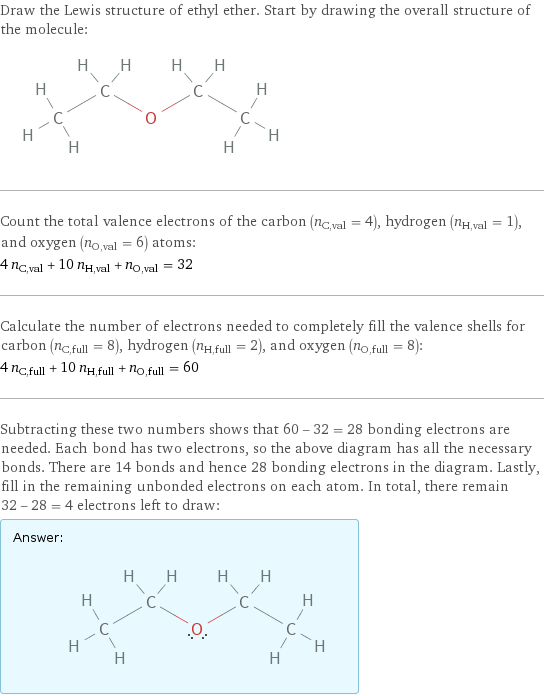
Draw the Lewis structure of ethyl ether. Start by drawing the overall structure of the molecule: Count the total valence electrons of the carbon (n_C, val = 4), hydrogen (n_H, val = 1), and oxygen (n_O, val = 6) atoms: 4 n_C, val + 10 n_H, val + n_O, val = 32 Calculate the number of electrons needed to completely fill the valence shells for carbon (n_C, full = 8), hydrogen (n_H, full = 2), and oxygen (n_O, full = 8): 4 n_C, full + 10 n_H, full + n_O, full = 60 Subtracting these two numbers shows that 60 - 32 = 28 bonding electrons are needed. Each bond has two electrons, so the above diagram has all the necessary bonds. There are 14 bonds and hence 28 bonding electrons in the diagram. Lastly, fill in the remaining unbonded electrons on each atom. In total, there remain 32 - 28 = 4 electrons left to draw: Answer: | |
3D structure
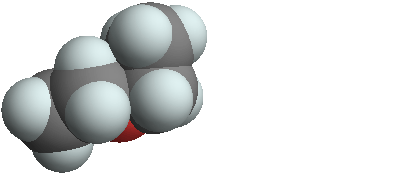
3D structure
Basic properties

molar mass | 74.12 g/mol phase | liquid (at STP) melting point | -116 °C boiling point | 34.6 °C density | 0.706 g/cm^3 dielectric constant | 4.197
Liquid properties (at STP)
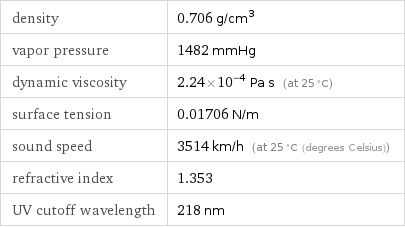
density | 0.706 g/cm^3 vapor pressure | 1482 mmHg dynamic viscosity | 2.24×10^-4 Pa s (at 25 °C) surface tension | 0.01706 N/m sound speed | 3514 km/h (at 25 °C (degrees Celsius)) refractive index | 1.353 UV cutoff wavelength | 218 nm
Units

Thermodynamic properties
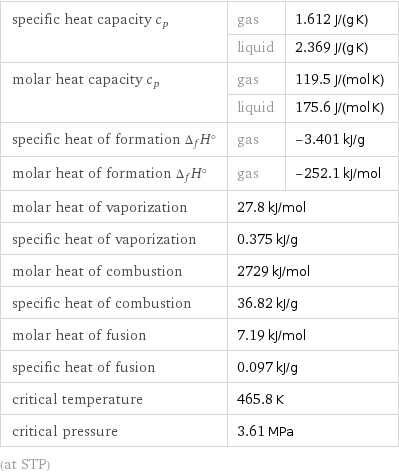
specific heat capacity c_p | gas | 1.612 J/(g K) | liquid | 2.369 J/(g K) molar heat capacity c_p | gas | 119.5 J/(mol K) | liquid | 175.6 J/(mol K) specific heat of formation Δ_fH° | gas | -3.401 kJ/g molar heat of formation Δ_fH° | gas | -252.1 kJ/mol molar heat of vaporization | 27.8 kJ/mol | specific heat of vaporization | 0.375 kJ/g | molar heat of combustion | 2729 kJ/mol | specific heat of combustion | 36.82 kJ/g | molar heat of fusion | 7.19 kJ/mol | specific heat of fusion | 0.097 kJ/g | critical temperature | 465.8 K | critical pressure | 3.61 MPa | (at STP)
Chemical identifiers
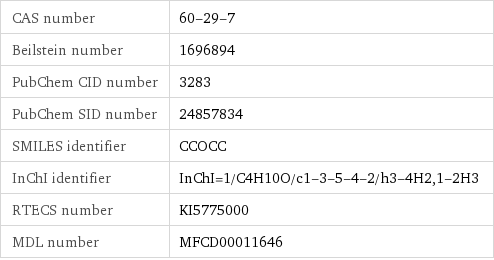
CAS number | 60-29-7 Beilstein number | 1696894 PubChem CID number | 3283 PubChem SID number | 24857834 SMILES identifier | CCOCC InChI identifier | InChI=1/C4H10O/c1-3-5-4-2/h3-4H2, 1-2H3 RTECS number | KI5775000 MDL number | MFCD00011646
NFPA label

NFPA label

NFPA health rating | 2 NFPA fire rating | 4 NFPA reactivity rating | 1
Safety properties
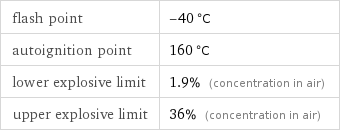
flash point | -40 °C autoignition point | 160 °C lower explosive limit | 1.9% (concentration in air) upper explosive limit | 36% (concentration in air)

DOT hazard class | 3 DOT numbers | 1155
Toxicity properties
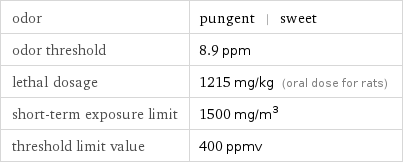
odor | pungent | sweet odor threshold | 8.9 ppm lethal dosage | 1215 mg/kg (oral dose for rats) short-term exposure limit | 1500 mg/m^3 threshold limit value | 400 ppmv

probable lethal dose for man | 600 mL (milliliters) long-term exposure limit | 1200 mg/m^3 (over 8 hours) RTECS classes | tumorigen | drug | mutagen | human data | primary irritant